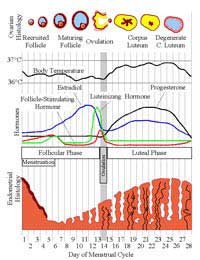Predicting Ovulation

To improve your chances of getting pregnant it’s helpful to get in tune with your menstrual cycle. When you ovulate, your body releases a mature ovum, or egg, from your ovaries and if you have intercourse around the same time, the egg will be in a prime position to be fertilised by sperm. But how do you know when you’ll ovulate and can the timing be predicted?
Ovulation usually occurs every four weeks, about 14 days before the start of your next menstrual period and normally only one egg is released at a time. The uterine lining will have built up ready for implantation, but if the egg isn’t fertilised by sperm, it will be discarded in the usual way and your period will arrive about two weeks later. It’s a very narrow time period, as it only lasts for 12 to 24 hours and conception is only possible during this phase.
Sometimes you may have what’s called an anovulatory cycle, where an egg isn’t released. It’s difficult to know when this has happened, as you still get a period even though you haven’t ovulated.
If you’re keen to get pregnant, getting to know your body and when you’re likely to be ovulating can be a helpful way of timing when’s best to have sex. There are various methods used to do this and they can either be used on their own, or in conjunction with each other. Here’s a rundown of the main methods.
Using an Ovulation Predictor Kit
It’s possible to purchase a predictor kit which will predict when you’re about to ovulate, or are already ovulating. It works by detecting an increase in the Lutenizing Hormone (LH) in the urine, or an LH surge. LH is released from the pituitary gland, triggering a rise in oestrogen which in turn causes an egg to be released from the ovum and into the fallopian tubes. It usually occurs about 24 to 36 hours before ovulation, so it’s a useful signal to have. It’s a simple test that only needs to be carried out when you’re mid-cycle, but it’s not foolproof. It doesn’t always work for women who have irregular cycles and if you’re taking fertility drugs, they may interfere with the results.Charting Your Basal Body Temperature
Before you ovulate, your average body temperature is 97.0 to 97.5 degrees Fahrenheit, but when you’re ovulating it increases by about 1-2F. It may sound like a small increase, but this change can be tracked and may help you when you’re trying to predict when ovulation will occur. The change in temperature is due to the release of the hormone progesterone and your temperature will stay elevated until your next monthly cycle begins, then go back to normal (unless you get pregnant, when it will continue).In order to track your basal body temperature, you need to start taking your temperature on the first day of your period and take it every day at the same time. It’s best to do it first thing in the morning, before you’ve moved around, showered or eaten breakfast, and to use an oral thermometer. Your readings may seem random for a while, but after a month or two you begin to notice a pattern. The method isn’t 100 per cent accurate, but it has been used for years and is easy and free to try.


Re: Ovary Transplants: Are They Possible?
Hi! I 37 years old single mather. I was ovary gonadoblastoma in 2013. Removed both ovaryes . I take hormon pills but…
Re: Ovary Transplants: Are They Possible?
I am a 54 year old women who went through an early menopause. Since then I have developed all sorts of issues which I…
Re: Ovary Transplants: Are They Possible?
I have pcos with it cure it if I have this done
Re: Ovary Transplants: Are They Possible?
We are from India and my wife got pregnant through IVF treatment, now she is in her 17th week of pregnancy. We have…
Re: Ovary Transplants: Are They Possible?
Janaka - Your Question:Hi everyone,My wife 28 years old, her both ovaries removed due to cyst after that she is facing…
Re: Ovary Transplants: Are They Possible?
Hi everyone, My wife 28 years old, her both ovaries removed due to cyst after that she is facing lot's lot's of…
Re: What Causes Sperm Loss?
I'm seeing only watered with little amount of white colour when it come out from my anus .wt is ur suggestions for this . please send reply.
Re: Ovary Transplants: Are They Possible?
I'm 38 years old , and I'm on HRT tablets because I have high hormones levels (FSH, LH) post menopausal, can I do…
Re: What Causes Sperm Loss?
Hi I am 23 year old , I had 5 wet dreams in within 9 days. This cenerio making me tense. Is this a problem ? The gap is not more then…
Re: What Causes Sperm Loss?
What can I use to generate loss of sleeps at the age of 60?